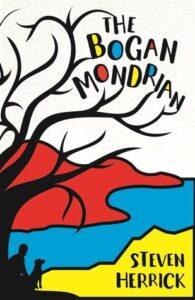 Steven Herrick has been a mainstay of Australian children’s and young adult literature for almost three decades, both in prose and verse novels. His latest offering, The Bogan Mondrian is typical of his style–evocative, lyrical and authentic. Here he talks about why he wrote this book. Thanks Steven, for sharing this with us.
Steven Herrick has been a mainstay of Australian children’s and young adult literature for almost three decades, both in prose and verse novels. His latest offering, The Bogan Mondrian is typical of his style–evocative, lyrical and authentic. Here he talks about why he wrote this book. Thanks Steven, for sharing this with us.
Fiction authors aren’t supposed to bother with statistics. We inhabit the world of character, emotion, myth and story, not sterile numbers and lists. We worship the image, the poetry of words, the craft of dialogue.
And yet in the clanging echo chamber of social-media, one statistic keeps tolling through my feed – the number of women killed by their partners in Australia. Each week, the smiling face of a wife, mother, sister is wreathed in comments by those who knew her and we others who mourn her senseless loss.
One in six women have been subjected to physical violence by a current or previous cohabiting partner. That figure sends me not to my keyboard but to my calculator. That’s a scarifying 1.6 million adult women. Imagine if that number of Australians were victims of terrorism, road trauma or cancer. It would be a National Emergency. The Prime Minister would put us on a war footing against this virulent predator.
What I find scarier is if we flip those figures. Even if we accept that each perpetrator is a triple offender, that leaves us with over 500,000 men with a history of violence against their partners. It’s highly likely we know one of these men – the neighbour, the mate at the club or the work associate. Yes, even the man I sit beside on stage at a Literary Festival. So the way we men talk about women, the jokes we tell, the messages we send can resonate all the way back to that family straining under violence, without us even being aware. Which means it’s never enough for a man to say ‘not all men are violent,’ and believe it’s someone else’s problem.
I’m an author of books for children and young adults. In my latest novel titled The Bogan Mondrian, after the death of his dad, teenage Luke sleepwalks through his days, jigging school, swimming at the reservoir and eating takeaway pizza. But when Charlotte, a young woman from a wealthy family, comes into his world, he realises there are worse things than school. Charlotte’s father beats his wife.
The choice of a well-to-do family was deliberate – domestic violence affects people from all classes, races and religions. In the novel, Luke becomes a catalyst for Charlotte confronting the violence happening behind the neatly-trimmed hedge, circular driveway and security door. I chose a teenage boy and girl because this is not a women’s issue – the notion of masculinity and our propensity to violence is for us to understand and fix. I hope Luke is an example of male strength, kindness and empathy. I hope he’s a believable antidote to the destruction wrought by Charlotte’s father.
Violence against women is inevitably about power. What kept nagging me during the writing of this book is how can we flip power away from these violent men. How as a family, and by extension as a community, can we stand firm, as Luke, Charlotte and her mother do in the story and say ‘enough.’
Charlotte’s father is a popular man, respected in the community and workplace. She comes to understand that his violence and brutality in the home is effectively masked by the narrative of the ‘good bloke’ in the neighbourhood. Aided by Luke, she uses this public persona against him. I don’t claim what Luke and Charlotte do in the novel is a solution to domestic violence – each family circumstance is different. I’m writing the personal not the polemic. I’ve spent fourteen months in my study creating character, writing dialogue, giving flesh and feelings to those statistics that keep haunting me. It’s not all I can do as a man, but I hope it’s a start.
copyright Steven Herrick 2018

